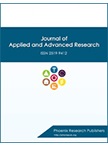Feeding values of conventional diets and their effects on the performances of dairy cows in Central Myanmar
DOI:
https://doi.org/10.21839/jaar.2016.v1i4.35Keywords:
Conventional diets, dairy cows, digestibility, nitrogen utilization, milk yieldAbstract
The conventional diets have been fed to dairy cows since many years ago in Myanmar, however there is a little scientific information regarding the use of those diets as feed. Therefore, this study was conducted to evaluate the feeding values of conventional diets and their effects on the performances of dairy cows in Central Myanmar. Nine cross-bred Holstein Friesian cows (460±22kg) with the 12th week of lactation were randomly allocated to one of three treatment groups with three replicates in a completely randomized design. The three treatments were Diet-ST (common diet from Sin Tel, Tatar U Township), Diet-MN (common diet from Myay Ngu, Tatar U Township) and Diet-AM (common diet from Amarapura Township). Cows were fed treatments for 60 days. The roughage to concentrate ratios ranged from 53:47 to 72:28 and the nutritive values were significantly different (p<0.05) each other. The highest nutrient intakes were observed in dairy cows fed on Diet-MN, however the nutrient digestibility were not different (p>0.05) except the CP and ether extract digestibility (CPD and EED). The nitrogen utilization was highest in dairy cows fed on Diet-ST and the lowest value was observed in the dairy cows fed on Diet-AM. Although the milk compositions were not different (p>0.05), the average milk yield of dairy cows offered the Diet-MN was significantly higher (p<0.05) than those of dairy cows fed on other diets. The highest total feed cost (p<0.05) was found in Diet-AM and the lowest value (p<0.05) was in Diet-MN. According to these findings, it was concluded that the highest feeding value was observed in Diet-MN and its effect on the performances of dairy cows was also greater than others. Moreover, it would be suggested that better bean residues and sesame residues could be used as fibre sources in the diets of dairy cows.





 .
.